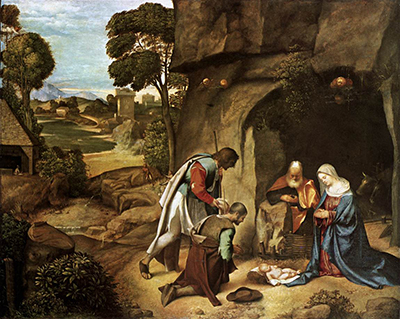The Adoration of the Shepherds is one of the few of Giorgione's works wholly and unanimously attributed to the artist.
Painted in c.1505 to 1510, there is no documentation to identify who commissioned the piece. However, it is a relatively small object, leading scholars to surmise that it was created for personal devotion rather than as an alter piece.
The Adoration of the Shepherds is still sometimes referred to as The Allendale Nativity as it belonged to the Viscounts of Allendale for almost a century (1847-1937). Over the centuries the painting has had many private owners. Eventually in 1937, it was gifted by the Samuel H. Kress Foundation to the National Gallery of Art in Washington DC, where it still hangs today.
True to Giorgione's style, The Adoration of the Shepherds has two clearly defined parts; the holy family and the shepherds to the right, and the beautiful, bright Italian landscape behind to the left. The artist’s love of nature and appreciation for landscape is often evident in his work and this painting is no exception.
Mary, Joseph and the Christ child are depicted sitting in front of a dark cave, rather than a stable. They are dressed in opulent clothing while the infant Jesus is naked and appears to be lying on the ground instead of the traditional manger. The shepherds are more modestly dressed and kneel before the new-born saviour. While the adoration scene is in the forefront and accounts for two thirds of the painting, behind and to the left is a vivid and bright venetian scene.
While the annunciation of the shepherds was quite a common subject for paintings of the time. However, depictions of Saint Luke’s gospel, indicating that the shepherds were the first to pay homage to the new King, were less customary. Giorgione's interpretation of the scene is a masterpiece and clearly illustrate his genius in use of colour and in composition. Subsequently, it became an ever more popular theme.
The meaning of The Adoration of the Shepherds is uncharacteristically simple. It is clearly a rendering of the shepherds honouring Jesus at his birth. However, the symbolism beneath the meaning is subtler and a great deal more profound.
In the interest of context, it is important to remember that during the 16 th century in Venice, the religious trends of the time were to conduct devotional services privately in your own home. Many of the influential nobility were repurposing areas of their homes as chapels and inviting priests to conduct services for their families and intimates in a more exclusive setting. Hence the growing fashion for smaller iconography for less voluminous venues. This may have prompted Giorgione to layer more meaning and significance into his religious works. The Adoration of the Shepherds could easily have been one such painting.
On first inspection it may appear odd that Jesus is lying, naked, on the stony ground. Yet, on closer inspection, the infant is actually laid upon a white cloth. This cloth is the same white cloth that covers the stone alter during mass. If this is the case, then the Child is the Eucharist or Naked Body of Christ presented during the sacraments. It then clearly follows that Giorgione has not only depicted Luke's gospel, but in fact, the first mass.
There are many other beautiful symbols within the painting; Joseph’s luminous golden robes signifying the royal house of David and Jesus' lineage, the laurel bush in the fore ground indicating joy and resurrection and of course the coming of a new and shining city on the hill suggested by the landscape in the background.
Giorgione was well known for was his love of nature and beautiful scenes, therefore using the pastoral theme of shepherds to show the love of the Christ child would seem an obvious option for him. Nonetheless, it is the great depth of meaning and devotional symbology that appear to have been the greatest inspiration to artists who followed. Titan, Giorgione’s great admirer and colleague, himself later painted many of the same iconology into his own Adoration of the Shepherds in 1533 including the naked Christ, the white cloth and Joseph’s golden robes. However, beautiful and accomplished though it may be, it lacks the luminosity and originality of Giorgione’s work.
Even though Giorgione's works are limited due to his early death, the significance of his genius is not to be underestimated. Many great artists later went on to undertake the subject of Luke’s words in some form or another, but none, not even Titian, managed to convey the profundity of meaning achieved by Giorgione. The Adoration of the Shepherds is a masterpiece of colour, light and sheer emotion that is yet to be surpassed.




